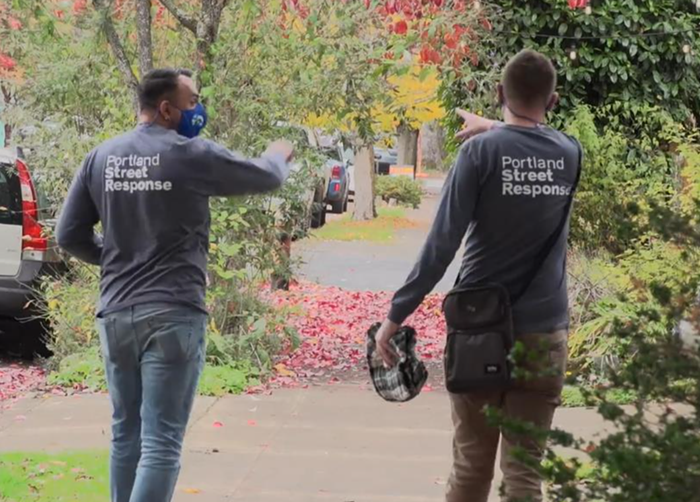IT ALL STARTED WITH A TRAILER FOR FIVE ELEMENT NINJAS.
A ridiculous 1982 Hong Kong kung fu flick made by the Shaw Brothers Studio, Five Element Ninjas pits ninjas of "gold, fire, water, wood, and land" against an army of unwitting Japanese fighters. Featuring such tasteful moments as one fighter tripping over his own spilling guts, Five Element Ninjas is a grindhouse classic.
It's also exactly the sort of film that catches the eye of Dan Halsted, who started Portland's Grindhouse Film Festival in 2004. Since then, Halsted has developed the festival into a monthly showcase of genre cinema that pits the sordid pulp of films like The Toolbox Murders against the antiseptic blandness of contemporary multiplexes.
The Grindhouse Film Festival's screenings are often preceded by vintage previews—but when the trailer for Five Element Ninjas played at the Grindhouse Trailer Festival in April, Halsted made a discovery that might very well change the American grindhouse scene forever.
MYTHS AND LEGENDS
Halsted, used to seeing film that's battered, faded, and scratched up, was amazed by the film quality of Five Element Ninjas' trailer—but despite inquiries, the man who sold Halsted the trailer refused to tell him where it came from. Luckily, Halsted found a movie ticket in the trailer's canister that led him, via Google, to a decrepit movie theater on the edge of Chinatown in Vancouver, British Columbia. The theatre had closed down in 1985, but after sending some wildly speculative emails to the theater's wealthy Chinese owners, Halsted got a quick and unexpected response granting him permission to go inside. Dazed, he drove to Canada with his girlfriend in early August, not knowing what to expect.
"Often we'll find films somewhere in the Midwest in a shed that's been sweating in the sun," says Justin Ishmael of the American Genre Film Archive (AGFA), a Texas nonprofit established last year to preserve grindhouse movies. "You hear these myths of, 'Oh, there's a theater this old man used to have with a rich vein of old films inside.' But no one finds that kind of stuff. Except Dan got it this time, and it's big. It's priceless."
"It really is," Ishmael insists. "It's not a cliché. There's a difference between a print existing, and a print existing. And Dan has just single-handedly doubled our collection of films."
THE BREAKDOWN
"Vancouver is a really nice, clean city," says Halsted. "Except there is one area that is just awful, and the old theater is right in the middle of it."
Halsted parked in the alley behind the theatre, after honking his horn to encourage three crack-smoking prostitutes to move out of the way. Later, as Halsted loaded pallets onto a truck in the alley, "This guy sits down next to us, smokes a rock, pulls up his pant leg, takes out a pocketknife, and starts slicing the sores off his leg," Halsted says.
The theater was recently reopened as a periodic live music venue, and a janitor pointed Halsted to a door that offered access to the area beneath the stage.
"The theater just sat there unused since '85," says Halsted. "The film was all stashed under the stage, and it was probably only a matter of time before it got damaged by somebody spilling a mop bucket or something."
The 30-by-10-foot space was full of film in disarray, lying outside its canisters. But for some reason—perhaps because the film could "breathe"—it was all in far better condition than one would expect. Old film often breaks down, thanks to what's known as "vinegar syndrome," in which the film ages, warps, begins to smell of vinegar, and becomes worthless. But the stash of films Halsted discovered barely had any vinegar syndrome at all. Stumbling across one or two films like these in such amazing condition would be a big find—but Halsted had discovered so much film that it took him and his girlfriend nine hours to sort through it all.
"It blew my mind," Halsted says. "I was overwhelmed, because there was so much. But I was also concerned, because I didn't know if any of the films were complete. But these are my favorite movies. They just don't exist on film [anymore], and to find them there, to be there and touch them, and in such great condition—it was unreal."
A COLLECTOR'S DREAM
There are less than 100 collectors of rare 35mm films in the United States, says Ishmael, and that's a figure that includes directors like Steven Spielberg, Martin Scorsese, and Quentin Tarantino, who shows off his archive during the semi-regular QT Film Fest at the world-renowned Alamo Drafthouse Cinema in Austin, Texas.
"It's kind of like this nerdy badge of honor," says Ishmael. "If you're a film collector, it almost means you're instant friends with other film collectors."
Halsted describes his find in Vancouver as something "out of my dreams." It's certainly something that will change how he runs the Grindhouse Film Festival. Last June, for example, when Halsted screened a copy of Seven Grandmasters at Portland's Hollywood Theatre, the print was purchased from a guy who had dug it out of a dumpster in the late '70s. "And it was just one movie," says Halsted. "But it was this huge deal."
At last count, Halsted has collected 140 complete movies from the Vancouver haul—and, once all the prints have been catalogued by the AGFA, that number is expected to rise to 200. An independent auditor valued the combined films at $27,000, and Halsted facilitated its donation to the Texas nonprofit by the theater owners. "They were happy to have the tax write-off," he smiles.
INVINCIBLE POLE FIGHTER
Born and raised in rural Oregon, Halsted seems modest and unassuming despite being over six feet tall. He wears Adidas, drinks drip coffee, and smiles only rarely. But he lights up when you ask him about 1984's Invincible Pole Fighter, the first of his found movies on loan from AGFA, which will be screened at the Hollywood on September 19.
"It's my favorite kung fu movie," he says. "I've had the bootleg of it forever."
In Vancouver in the early '80s, the audience for Invincible Pole Fighter would probably have been very different from today, Halsted notes. "I don't think it would've been your typical rowdy grindhouse experience," he says. "In that setting, it was probably a serious movie-watching experience for almost exclusively Chinese audiences."
Directed by Lau Kar-Leung, Invincible Pole Fighter stars kung fu legends Gordon Liu (who Tarantino would later cast in his Kill Bill movies) and Fu Sheng, who died in a car crash during the filming.
Invincible Pole Fighter was also shot during an era when many Hong Kong kung fu movies started to stray into comedy, "which can be annoying," notes Halsted. But this film maintains a serious tone throughout. "I think because of Fu Sheng dying, it cast this dark cloud over the entire production," Halsted says, adding that the highlight of the movie is its final reel.
"It's Kar-Leung's masterpiece," he says, without giving too much away. "That final scene is incredible. It's amazing. People are gonna lose their minds."
Courtesy of AGFA, Halsted plans to screen many more movies from his Vancouver haul over the coming months—while searching for the next big grindhouse goldmine.



















